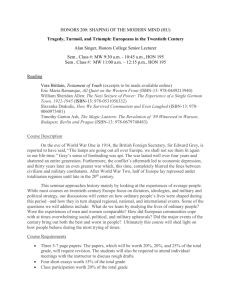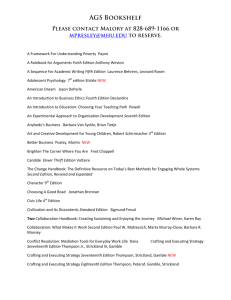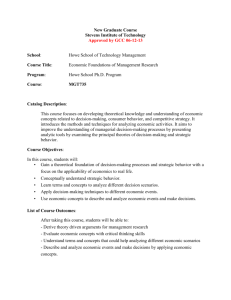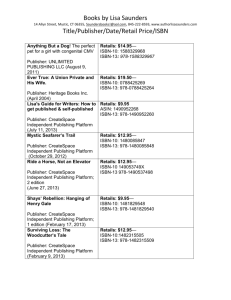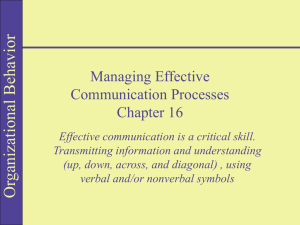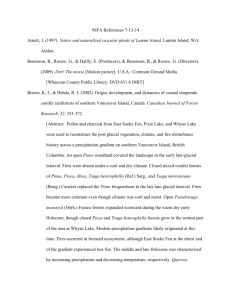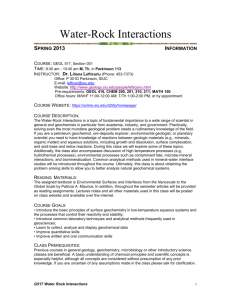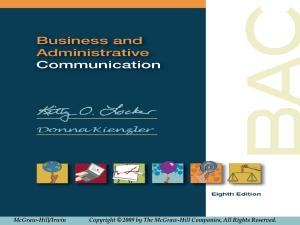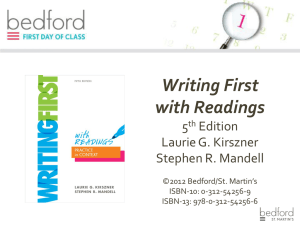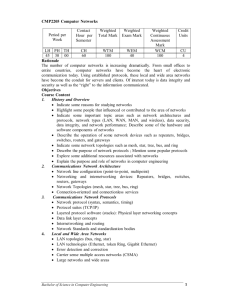Succeeding in Business Communication
advertisement
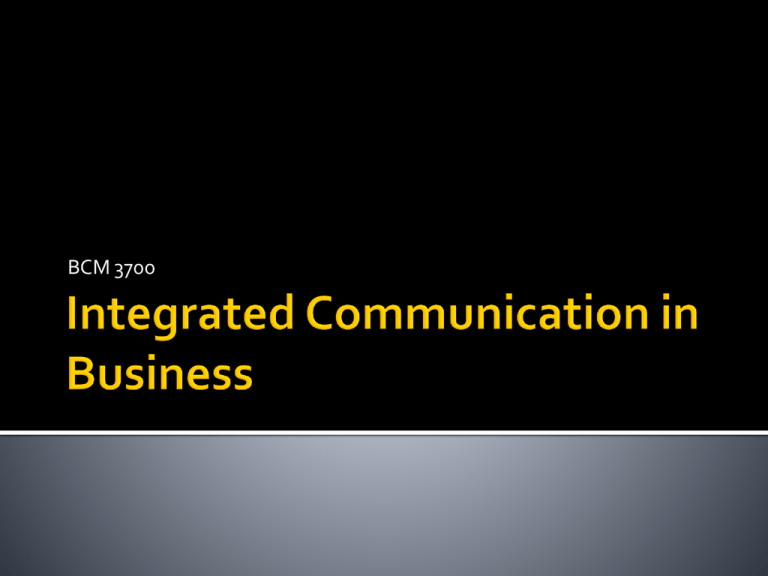
BCM 3700 Welcome, syllabus, schedule, etc. Chapter 1: Achieving Success Through Effective Business Communication Assignments Excellence in Business Communication, 11/E John V. Thill Courtland L. Bovee ©2015 ISBN-10: 0133544176 ISBN-13: 9780133544176 Excellence in Business Communication, 10/E John V. Thill Courtland L. Bovee ©2013 ISBN-10: 0132719045 ISBN-13: 9780132719049 Excellence in Business Communication, 9/E John V. Thill Courtland L. Bovee ©2011 ISBN-10: 0136103766 ISBN-13: 9780136103769 Easy Writer 5th Edition Andrea A. Lunsford ©2014 ISBN-13: 9781457640469 Create and Maintain a Blog (5%) Job Package (10%) Individual Oral Presentation (10%) Seven (smaller) Assignments “Self” Analysis (6%) Informative Message (6%) Positive Message (6%) Persuasive and Sales Messages (6%) Negative Message (6%) Designing Flyers and Forms (6%) Visual Impression Analysis (6%) Two (larger) Projects One (three-part) Team Project Team Report & Presentation (10%) Progress Report and Outline (3%) Final exam (10%) Class contributions (10%) BCM 3700 Achieving Success Through Effective Business Communication “Communication is an essential part of life, but where business is concerned, it is critical to success.” ~sixsigmaonline.org “In nature, language is what sets us apart from the animals. In business, it's what sets true leaders apart from perpetual followers. That's because communicating effectively can make all the difference between success and failure as a manager.” ~Harvard Business Review, 2014 “In business, what we say – and how we say it – equates to who we are. And the way in which we communicate is as important as our brand... Whether creating a multi-million dollar Super Bowl ad at the pinnacle of a career or participating in an interview for an entry-level job at the onset of a career, the language choices we make are given tremendous significance by our peers, by those in the board room and by those with the decision making power to hire us.” ~~Brett West, CommPRO.biz, 2013 Communication helps organizations and the people in them achieve their goals. The ability to write and speak well becomes increasingly important as you rise in an organization. Career Advancement Improving your communication skills may be the single most important step you can take in your career. Ability to Share Complex Ideas Even great ideas won’t go anywhere without great communication. Enhance Entrepreneurial Endeavors If you learn to write well, speak well, listen well, and recognize the appropriate way to communicate in any situation, you’ll gain a major advantage that will serve you throughout your career. Become an Effective Leader As you take on leadership and management roles, communication becomes even more important. Public perception – customers, suppliers, peers, Internal perception – staff Closer ties with important communities in the marketplace Increased productivity and faster problem solving Improve employee engagement and satisfaction Better financial results and higher return for investors Opportunities to influence conversations, perceptions, and trends Stronger decision making More persuasive marketing messages You must… Provide useful practical information Give facts and evidence Be concise Be clear Be persuasive Verbal Nonverbal Face-to-face • Computer graphics Phone • Company logos conversations Informal meetings Presentations E-mail messages Letters • Smiles • Size of an office • Location of people at meetings All business communication has three basic purposes 1. 2. 3. To inform (explain or tell an audience something) To request or persuade (want the audience to act) To build goodwill (make good image—the kind of image that makes people want to do business with you. ) Most messages have more than one purpose Example: When you write an e-mail to co-workers asking a question, you inform them about your situation, persuade them to help you, and try to build a good image of yourself as someone who wants to resolve an issue. Internal Messages go to people inside the organization Memo to subordinates, superiors, peers External Messages go to people outside the organization Letter to customers, suppliers, others Effective writing Saves time Increases one’s productivity Communicates points more clearly Builds goodwill Poor writing Wastes time Wastes effort Loses goodwill Good business writing meets five basic criteria: 1. Clear: The meaning the audience gets is the meaning the communicator intended. 2. Complete: All of the audience’s questions are answered 3. Correct: All of the information in the message is accurate 4. Saves Time: The style, organization, and visual or aural impact of the message help the receivers read, understand, and act on the information as quickly as possible 5. Builds Goodwill: The message presents a positive image of the communicator and his or her organization Conventions Widely accepted practices you routinely encounter Vary by organizational setting Help people… ▪ recognize, produce, and interpret communications Need to fit rhetorical situation: ▪ audience, context, and purpose What questions should I ask??… What’s at stake? To whom should you send a message? What channel should you use? What should you say? How should you say it? Six-step process for effective messages… 1. Analyze (following 6 questions) 2. Organize 3. Make it Readable 4. Make it Positive 5. Edit & Proofread 6. Follow-up Strategy Answer the following six questions… 1. Who are your audiences? 2. What are your purposes? 3. What information must you include? 4. How can you support your position? 5. What audience objections do you expect? 6. What part of context may affect audience reaction? Organize to Fit Audience, Purpose, Situation 1. Put good news first 2. Put the main point/question first -or3. Persuade a reluctant audience by delaying the main point/question Make Message Look Inviting Use subject line to orient reader Use headings to group related ideas Use lists for emphasis Number items if order matters Use short paragraphs—six lines max. Create Positive Style Emphasize positive information Give it more space Use indented list to set it off Omit negative words, if you can Focus on possibilities, not limitations Check… Spelling Grammar Punctuation Double-check… Reader’s Name(s) Numbers First and Last ¶ Always always always proofread before sending Use Response to Plan Next Message Evaluate feedback you get If message fails, find out why If message succeeds, find out why Success = results you want, when you want them All of these aspects are present in any business communication …but some might be more emphasized or obvious in certain typed of communication. These aspects are also highly interdependent, …but we separate them for clarification, discussion, and grading. 1. Task/Context: “Context” can be defined as… ▪ the “time, place, and situation” or ▪ the “big picture” for communication. Successful business communicators know that messages never occur in vacuums… ▪ but are viewed within the larger situations that surround them. 2. Audience: the recipient(s) of the message… ▪ ▪ ▪ ▪ whether that be an individual, a group, a market, or a public. “Audience” discussions include… ▪ analysis (what’s important about the audience) ▪ adaptation (how that affects the message) ▪ approaches to particular types of audiences 3. Channel Choice: A key consideration, given the proliferation of media and how different they are. Effective communicators make wise choices, recognizing the need for… ▪ ▪ ▪ ▪ documentation, speed, direct contact, opportunities for interaction, etc. 4. Organization: Smart communicators ask themselves… “What goes where?” and the related question “What follows what?” When they do, they worry about… ▪ the order of elements they are working with ▪ the relationships among those elements (e.g. visual coherence or transitions). 5. Content: In business, “content” covers ▪ what is said (or written)… ▪ what is omitted ▪ how much of it to include about each point Many business communicators forget to consider the importance of amount for small and large areas. 6. Self-expression: awareness of the “self” you’re presenting is critical for any business student. The presenter’s ▪ ▪ ▪ ▪ ▪ credibility, confidence, reputation, appearance, attention to details …are all parts of self expression. “Selves” here are not just individuals, ▪ Departments ▪ Organizations ▪ (A communicator often represents the “face” of an organization.) 7. Visual Impression/Format: “Organization” refers to the ordering of content, “Visual Impression/Format” treat its ▪ placement, ▪ depiction, ▪ proportions on a page (paper, PowerPoint slide, Web page, etc.). These considerations include conventions for formats like where the date is placed on a page (often specific to organizations), as well as aesthetic and functional design decisions. 8. Mechanics/Language use: Two discrete (though often blurred) aspects are at work here… conventions & style. “Conventions” (spelling, punctuation, grammar) ▪ are matters of “right and wrong” which can be corrected. “Style” (word choice and sentence structure) ▪ treats matters of effectiveness and ▪ is often more difficult to define. Get your textbook (bookstore or online) Read: Chapter 1: Achieving Success Through Effective Business Communication Chapter 4: Planning Business Messages Chapter 5: Writing Business Messages Chapter 6: Completing Business Messages Chapter 8: Writing Routine and Positive Business Messages Locate the course website (URL on your syllabus) Bookmark it Pay attention to the “Class Notes” Create your own blog Instructions on the web (under “Resources”) “Describe what you hope to gain this semester from BCM 3700” Email the web address to your instructor BUS 3700
